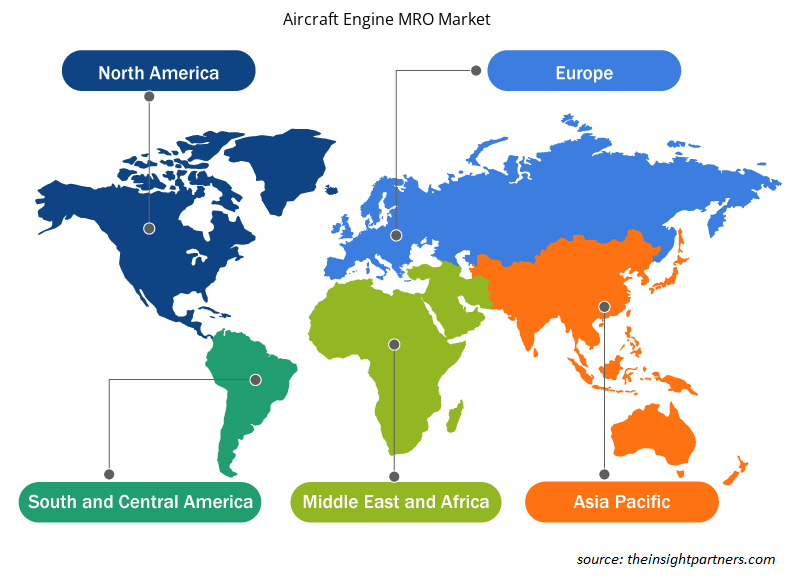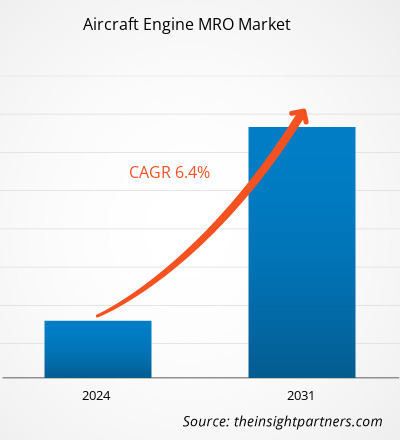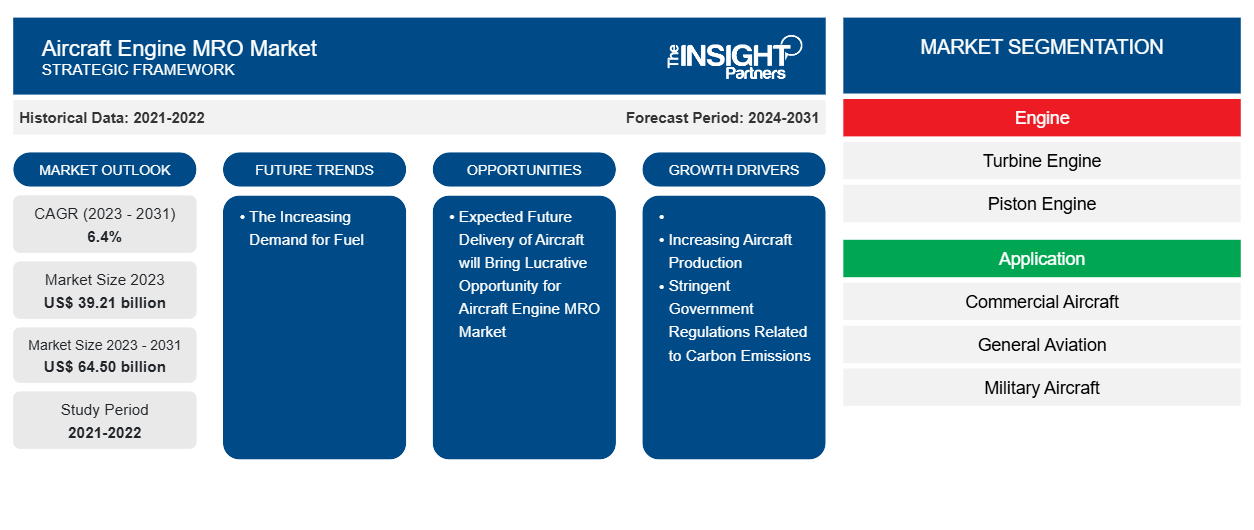Si prevede che la dimensione del mercato MRO dei motori aeronautici raggiungerà i 64,50 miliardi di dollari entro il 2031, rispetto ai 39,21 miliardi di dollari del 2023. Si prevede che il mercato registrerà un CAGR del 6,4% nel 2023-2031. La crescente domanda di aeromobili a basso consumo di carburante rimarrà probabilmente una tendenza chiave del mercato MRO dei motori aeronautici.
Analisi del mercato MRO dei motori aeronautici
Gli aeroporti in tutto il mondo hanno vari tipi di strutture MRO per motori. Di solito, la manutenzione viene eseguita sulla cellula dell'aereo o sul motore. I servizi MRO per motori includono anche la MRO dei componenti al giorno d'oggi. A seconda del tipo di servizio, questi servizi vengono forniti in aeroporto e, a volte, in strutture esterne all'aeroporto. Attività come ispezioni di routine, risoluzione regolare dei problemi o controlli giornalieri del motore possono essere eseguite quando l'aereo è parcheggiato nel terminal.
Panoramica del mercato MRO dei motori aeronautici
Una delle applicazioni principali della MRO dei motori aeronautici è garantire che tutti gli stadi rotanti del motore siano bilanciati e mantengano livelli minimi di vibrazione. Ciò migliora la durata e l'efficienza del carburante del motore e limita la quantità di usura del motore dovuta alle vibrazioni. Aggiornando i motori aeronautici e i componenti ad essi correlati, aumenterà anche la necessità di infrastrutture avanzate e manodopera qualificata per la MRO dei motori aeronautici. Il requisito MRO dei motori varia in base al tipo e alle categorie dei motori. I motori aeronautici più vecchi e più piccoli hanno tempi tra le revisioni (TBO) di un massimo di 5.000 ore. I motori moderni hanno più di 6.000 ore di TBO. Con un numero maggiore di aeromobili commerciali che volano meno di 500 ore all'anno, il requisito del servizio MRO del motore è in media di 12 anni o più.
Personalizza questo report in base alle tue esigenze
Riceverai la personalizzazione gratuita di qualsiasi report, comprese parti di questo report, o analisi a livello nazionale, pacchetto dati Excel, oltre a usufruire di grandi offerte e sconti per start-up e università
-
Scopri le principali tendenze di mercato in questo rapporto.Questo campione GRATUITO includerà analisi di dati che spaziano dalle tendenze di mercato alle stime e alle previsioni.
Driver e opportunità del mercato MRO dei motori aeronautici
Rigorose normative governative relative alle emissioni di carbonio
Nel 2021, il governo degli Stati Uniti ha annunciato il suo obiettivo di ridurre del 20% le emissioni degli aerei entro il 2030. Diverse autorità di regolamentazione stanno implementando strategie per ridurre le emissioni di carbonio. Ad esempio, a marzo 2022, l'International Air Transport Association (IATA) ha stimato che entro il 2050 saranno effettuati più di 10 miliardi di viaggi all'anno tramite voli e ha quindi annunciato di raggiungere emissioni di carbonio nette pari a zero entro il 2050.
Oltre il 60% dei paesi in tutto il mondo ha annunciato un'emissione netta di carbonio pari a zero. Anche aziende come Honeywell Aerospace si sono impegnate a raggiungere emissioni nette di carbonio pari a zero entro il 2035. A novembre 2021, Bell Textron Inc. ha annunciato che il Bell 525 ha completato il suo primo volo utilizzando carburante per aviazione sostenibile. Boeing e Airbus hanno recentemente annunciato che entro il 2030 i loro aerei voleranno al 100% con SAF. I governi degli Stati Uniti e dell'Europa sono incoraggiati a produrre SAF. Questi fattori stanno spingendo in modo sostanziale il mercato MRO dei motori aeronautici.Textron Inc. announced that Bell 525 completed its first flight utilizing sustainable aviation fuel. Boeing and Airbus have recently announced that by 2030, their aircraft will fly 100% on SAF. The US and European governments are encouraged to produce SAFs. These factors are propelling the aircraft engine MRO market substantially.
Consegna futura prevista di aeromobili commerciali: un'opportunità nel mercato MRO dei motori aeronauticiMRO Market
Con l'aumento del traffico aereo e della domanda di aeromobili, le compagnie aeree stanno incrementando la consegna dei loro aeromobili. La domanda di nuove compagnie aeree non proviene solo dagli aeromobili esistenti che ripristinano la loro flotta, ma anche dai nuovi aeromobili low-cost che entrano nel mercato. Un interesse represso dei viaggiatori per piacere che sono più sensibili ai costi dopo la pandemia, un interesse ridotto nei viaggi d'affari e l'adattabilità del piano d'azione per aeromobili a spesa minima stanno aumentando la domanda di servizi MRO. Inoltre, secondo le previsioni di Boeing e Airbus, si prevede che entro la fine del 2042 saranno consegnati oltre 40.800 aeromobili commerciali, il che spingerà ulteriormente l'implementazione di nuovi motori nella produzione di tali aeromobili. Ciò aumenterà ulteriormente la flotta complessiva di aeromobili a livello globale e genererà la domanda di MRO dei motori nonché di venditori di mercato nei prossimi anni.MRO services. Moreover, according to the Boeing and Airbus forecasts, more than 40,800 commercial aircraft are expected to be delivered by the end of 2042 which further drives the deployment of new engines into those aircraft production. This will further increase the overall aircraft fleet globally and generate the demand for engine MRO as well as market vendors in the coming years.
Analisi della segmentazione del rapporto di mercato MRO dei motori aeronauticiMRO Market Report Segmentation Analysis
I segmenti chiave che hanno contribuito alla derivazione dell'analisi del mercato MRO dei motori aeronautici sono il motore, l'applicazione e il tipo di aeromobile.
Motore [motore a turbina (motore turboelica, motore turbofan, motore turboalbero), motore a pistoni], applicazione (aerei commerciali, aviazione generale, aerei militari), tipo di aeromobile (ala fissa, ala rotante)
- In base al motore, il mercato MRO dei motori aeronautici è segmentato in motori a turbina e motori a pistoni. Inoltre, i motori a turbina sono stati ulteriormente segmentati in motori turboelica, motori turbofan e motori turboalbero. Il segmento dei motori a turbina ha detenuto una quota di mercato maggiore nel 2023.
- In base all'applicazione, il mercato è segmentato in aeromobili commerciali, aviazione generale e aeromobili militari. Il segmento degli aeromobili commerciali ha detenuto una quota di mercato maggiore nel 2023.
- In base al tipo di aeromobile, il mercato è segmentato in ala fissa e ala rotante. Il segmento ad ala fissa ha detenuto una quota di mercato maggiore nel 2023.
Analisi della quota di mercato MRO dei motori aeronautici per area geografica
L'ambito geografico del rapporto sul mercato MRO dei motori aeronautici è suddiviso principalmente in cinque regioni: Nord America, Asia Pacifico, Europa, Medio Oriente e Africa e Sud America.
Nel 2023, l'Asia Pacifica ha rappresentato una quota importante del mercato globale MRO dei motori aeronautici, seguita da Nord America ed Europa. L'economia asiatica è stata alimentata da una vasta gamma di livelli di reddito e da una classe media in rapida espansione. Ciò ha portato a una forte crescita delle vendite nelle economie in rapida crescita della regione, come India e Cina. Si prevede che l'APAC sarà il mercato con maggiori prospettive per i fornitori di servizi MRO per aeromobili. La regione contiene diverse economie in via di sviluppo che stanno aprendo la strada in una serie di settori, come aerospaziale, militare e difesa e tecnologia. Molte economie in crescita nell'APAC stanno cercando investimenti normativi per migliorare le loro tecnologie. Ciò alla fine stimolerebbe lo sviluppo e l'uso di nuove tecnologie per l'integrazione degli aeromobili . Diverse compagnie aeree nell'APAC, come Singapore Airlines e Malaysian Airlines, stanno sviluppando le loro capacità di manutenzione interna. Pratt & Whitney, un'azienda aerospaziale con sede negli Stati Uniti, ha aggiunto la capacità MRO per il suo turbofan con ingranaggi PW100G-JM presso il suo stabilimento Eagle Services Asia a Singapore nel 2019. Nel corso degli anni, questo stabilimento ha revisionato i motori Pratt & Whitney GTF. Con il lancio del motore PW100G-JM, si prevede che la struttura registrerà un aumento significativo dei ricavi da parte di vari operatori di aeromobili che utilizzano il PW100G-JM. Inoltre, la crescente implementazione di tecnologie di retrofitting per aeromobili migliorati e la fiorente adozione della tecnologia blockchain sono tra i principali fattori che guidano la crescita del mercato MRO dei motori aeronautici. Inoltre, la crescita del mercato nell'area Asia-Pacifico è attribuita all'aumento della flotta di aeromobili dovuto al crescente traffico passeggeri; all'aumento della spesa per gli aeromobili militari alimentati dal crescente budget della difesa; e ai progetti in corso di sviluppo di aeromobili commerciali, di aviazione generale e militari.MRO market followed by North America and Europe. Asia's economy has been fueled by a diverse range of income levels and a fast-expanding middle class. This resulted in strong sales growth in the region's fast-growing economies, such as India and China. APAC is predicted to be the market with the most prospects for aircraft MRO service providers. The region contains several developing economies that are leading the way in a range of industries, such as aerospace, military & defense, and technology. Many growing economies in APAC are seeking regulatory investment to improve their technologies. This would eventually spur the development and use of new technologies for aircraft MRO capability for its PW100G-JM geared turbofan at its Eagle Services Asia plant in Singapore in 2019. Over the years, this plant has been overhauling Pratt & Whitney GTF engines. With the launch of the PW100G-JM engine, the facility is expected to see a significant increase in revenue from various aircraft operators who use the PW100G-JM. Additionally, the rising deployment of retrofitting technologies for improved aircraft and the burgeoning adoption of blockchain technology are among the major factors driving the growth of the aircraft engine MRO market. Also, the growth of the market in Asia Pacific is attributed to the increasing aircraft fleet owing to the rising passenger traffic; increasing spending on military aircraft propelled by growing defense budget; and the ongoing projects of the development of commercial, general aviation, and military aircraft.
Approfondimenti regionali sul mercato MRO dei motori aeronautici
Le tendenze regionali e i fattori che influenzano il mercato MRO dei motori aeronautici durante il periodo di previsione sono stati ampiamente spiegati dagli analisti di Insight Partners. Questa sezione discute anche i segmenti e la geografia del mercato MRO dei motori aeronautici in Nord America, Europa, Asia Pacifico, Medio Oriente e Africa e America meridionale e centrale.

- Ottieni i dati specifici regionali per il mercato MRO dei motori aeronautici
Ambito del rapporto di mercato MRO dei motori aeronautici
| Attributo del report | Dettagli |
|---|---|
| Dimensioni del mercato nel 2023 | 39,21 miliardi di dollari USA |
| Dimensioni del mercato entro il 2031 | 64,50 miliardi di dollari USA |
| CAGR globale (2023-2031) | 6,4% |
| Dati storici | 2021-2022 |
| Periodo di previsione | 2024-2031 |
| Segmenti coperti |
Per motore
|
| Regioni e Paesi coperti |
America del Nord
|
| Leader di mercato e profili aziendali chiave |
|
Densità degli attori del mercato: comprendere il suo impatto sulle dinamiche aziendali
Il mercato MRO dei motori aeronautici sta crescendo rapidamente, spinto dalla crescente domanda degli utenti finali dovuta a fattori quali l'evoluzione delle preferenze dei consumatori, i progressi tecnologici e una maggiore consapevolezza dei vantaggi del prodotto. Con l'aumento della domanda, le aziende stanno ampliando le loro offerte, innovando per soddisfare le esigenze dei consumatori e capitalizzando sulle tendenze emergenti, il che alimenta ulteriormente la crescita del mercato.
La densità degli operatori di mercato si riferisce alla distribuzione di aziende o società che operano in un particolare mercato o settore. Indica quanti concorrenti (operatori di mercato) sono presenti in un dato spazio di mercato in relazione alle sue dimensioni o al valore di mercato totale.
Le principali aziende che operano nel mercato della manutenzione, riparazione e revisione dei motori aeronautici sono:
- Delta Airlines, Inc.
- Aviazione GE
- CFM Internazionale
- Tecnica Lufthansa
- MTU Aero Engines AG
- Società di Ingegneria SIA
Disclaimer : le aziende elencate sopra non sono classificate secondo un ordine particolare.

- Ottieni una panoramica dei principali attori del mercato MRO dei motori aeronautici
Notizie e sviluppi recenti sul mercato MRO dei motori aeronautici
Il mercato MRO dei motori aeronautici viene valutato raccogliendo dati qualitativi e quantitativi dopo la ricerca primaria e secondaria, che include importanti pubblicazioni aziendali, dati associativi e database. Di seguito è riportato un elenco degli sviluppi nel mercato per innovazioni, espansione aziendale e strategie:
- Ad aprile 2024, ITP Aero ha firmato un contratto con il Ministero della Difesa colombiano per la manutenzione, riparazione e revisione (MRO) dei motori T700 che alimentano la flotta di elicotteri Black Hawk delle sue Forze Armate. Il contratto durerà fino a giugno 2026 e i servizi MRO per i motori saranno eseguiti presso le strutture di ITP Aero ad Albacete (Spagna). (Fonte: ITP Aero, comunicato stampa)
- Nel novembre 2023, MTU Maintenance ha firmato un contratto quinquennale LEAP-1A di manutenzione, riparazione e revisione (MRO) con SriLankan Airlines, basandosi sul rapporto esistente tra le due aziende che ha anche coperto i motori V2500 e il supporto di leasing. La compagnia aerea nazionale dello Sri Lanka attualmente gestisce una flotta di 22 Airbus A330 e velivoli A320/A321 ed effettua voli in Asia meridionale, Europa, Estremo Oriente e Medio Oriente. (Fonte: MTU Maintenance, Newsletter)
Copertura e risultati del rapporto di mercato MRO dei motori aeronautici
Il rapporto "Dimensioni e previsioni del mercato MRO dei motori degli aeromobili (2021-2031)" fornisce un'analisi dettagliata del mercato che copre le seguenti aree:
- Dimensioni e previsioni del mercato MRO dei motori aeronautici a livello globale, regionale e nazionale per tutti i segmenti di mercato chiave coperti dall'ambito
- Dinamiche di mercato come fattori trainanti, vincoli e opportunità chiave
- Tendenze del mercato MRO dei motori aeronautici
- Le cinque forze di Porter in dettaglio
- Analisi di mercato MRO dei motori aeronautici che copre le principali tendenze del mercato, il quadro globale e regionale, i principali attori, le normative e i recenti sviluppi del mercato
- Analisi del panorama del settore MRO dei motori aeronautici e della concorrenza che copre la concentrazione del mercato, l'analisi della mappa di calore, i principali attori e gli sviluppi recenti
- Profili aziendali dettagliati
- Analisi storica (2 anni), anno base, previsione (7 anni) con CAGR
- Analisi PEST e SWOT
- Valore/volume delle dimensioni del mercato - Globale, Regionale, Nazionale
- Industria e panorama competitivo
- Set di dati Excel
Report recenti
Testimonianze
Motivo dell'acquisto
- Processo decisionale informato
- Comprensione delle dinamiche di mercato
- Analisi competitiva
- Analisi dei clienti
- Previsioni di mercato
- Mitigazione del rischio
- Pianificazione strategica
- Giustificazione degli investimenti
- Identificazione dei mercati emergenti
- Miglioramento delle strategie di marketing
- Aumento dell'efficienza operativa
- Allineamento alle tendenze normative























 Ottieni un campione gratuito per - Mercato MRO dei motori aeronautici
Ottieni un campione gratuito per - Mercato MRO dei motori aeronautici